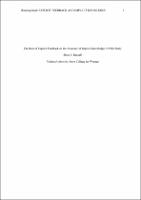Please use this identifier to cite or link to this item:
https://hdl.handle.net/20.500.12202/4221Full metadata record
| DC Field | Value | Language |
|---|---|---|
| dc.contributor.author | Russell, Shira B. | - |
| dc.date.accessioned | 2018-11-12T20:49:59Z | - |
| dc.date.available | 2018-11-12T20:49:59Z | - |
| dc.date.issued | 2015 | - |
| dc.identifier.uri | https://hdl.handle.net/20.500.12202/4221 | - |
| dc.identifier.uri | https://ezproxy.yu.edu/login?url=https://repository.yu.edu/handle/20.500.12202/4221 | |
| dc.description | The file is restricted for YU community access only. | - |
| dc.description.abstract | Researchers have shown that intuition is responsible for some of the most important decisions people make in both big-picture and every-day contexts. There is currently little research on the role of immediate feedback on intuition, and there is contradicting evidence as to whether immediate feedback actually improves intuition (Mathews et al., 1989) or whether it only maintains intuition (Mealor & Dienes, 2013; Kahneman, 2011). The current study focuses on the role of immediate feedback on intuition, specifically in the context of language learning and development. The Artificial Grammar Learning Task (originally created by Reber, 1967) was conducted on 42 Stern College participants, consisting of a feedback and no feedback condition. During the training phase, 45 consecutive sequences of letters were displayed on the screen for five seconds each. After the sequence disappeared, the participants were instructed to write down the sequence they just saw to the best of their abilities. Half of the participants were trained with sequences that were consistent with Grammar A and half with sequences consistent with Grammar B. Following the training phase, the participants were told that the sequences they just reviewed followed a specific “grammar rule” and they would now be shown new sequences in the testing phase. Participants were presented with 120 novel sequences (or trials), 60 of the sequences belonging to a grammar in which they were trained and 60 sequences belonging to the untrained grammar, all presented in a random order. After each sequence was displayed, participants were asked to answer whether the displayed sequence matched the grammar of the training phase, and if there judgment was a random guess, intuition, familiarity, recollection, or rules. Participants were also asked to rate the confidence levels of their judgments from 50-100%. Participants in the feedback condition were then given immediate feedback on whether their judgment about the grammar of the particular sequence was correct or not. A 4 × 2 Mixed Factorial ANOVA (Block [block 1 vs. block 2 vs. block 3 vs. block 4] × Feedback [feedback vs. no feedback]) showed that the predicted main effect for feedback condition and the interaction effect between the blocks and feedback condition were not significant. However, there was a significant block effect reflected in a continuous decline in performance over successive blocks. Additionally, when grammar A was isolated to measure the hits and false alarms, the feedback condition displayed a consistent pattern of more hits and less false alarms as time went on while the no feedback condition displayed the reverse pattern. These patterns are suggestive of a potential impact feedback may have on the underlying nature of implicit decision-making. Implications of the results and further research directions for the cognitive mechanisms and neurobiology of intuition/implicit knowledge were discussed. | en_US |
| dc.description.sponsorship | S. Daniel Abraham Honors Program | en_US |
| dc.language.iso | en_US | en_US |
| dc.publisher | Stern College for Women | en_US |
| dc.rights | Attribution-NonCommercial-NoDerivs 3.0 United States | * |
| dc.rights.uri | http://creativecommons.org/licenses/by-nc-nd/3.0/us/ | * |
| dc.subject | Feedback (Psychology) | en_US |
| dc.subject | Intuition. | en_US |
| dc.subject | Decision making. | en_US |
| dc.title | The Role of Explicit Feedback on the Accuracy of Implicit Knowledge: A Pilot Study | en_US |
| dc.type | Thesis | en_US |
| Appears in Collections: | S. Daniel Abraham Honors Student Theses | |
Files in This Item:
| File | Description | Size | Format | |
|---|---|---|---|---|
| Shira-Russell.pdf Restricted Access | 573.49 kB | Adobe PDF |  View/Open |
This item is licensed under a Creative Commons License

